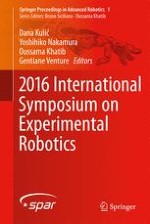2017 | OriginalPaper | Chapter
Core Actuation Promotes Self-manipulability on a Direct-Drive Quadrupedal Robot
Authors : Jeffrey Duperret, Benjamin Kramer, Daniel E. Koditschek
Published in: 2016 International Symposium on Experimental Robotics
Publisher: Springer International Publishing
Activate our intelligent search to find suitable subject content or patents.
Select sections of text to find matching patents with Artificial Intelligence. powered by
Select sections of text to find additional relevant content using AI-assisted search. powered by
